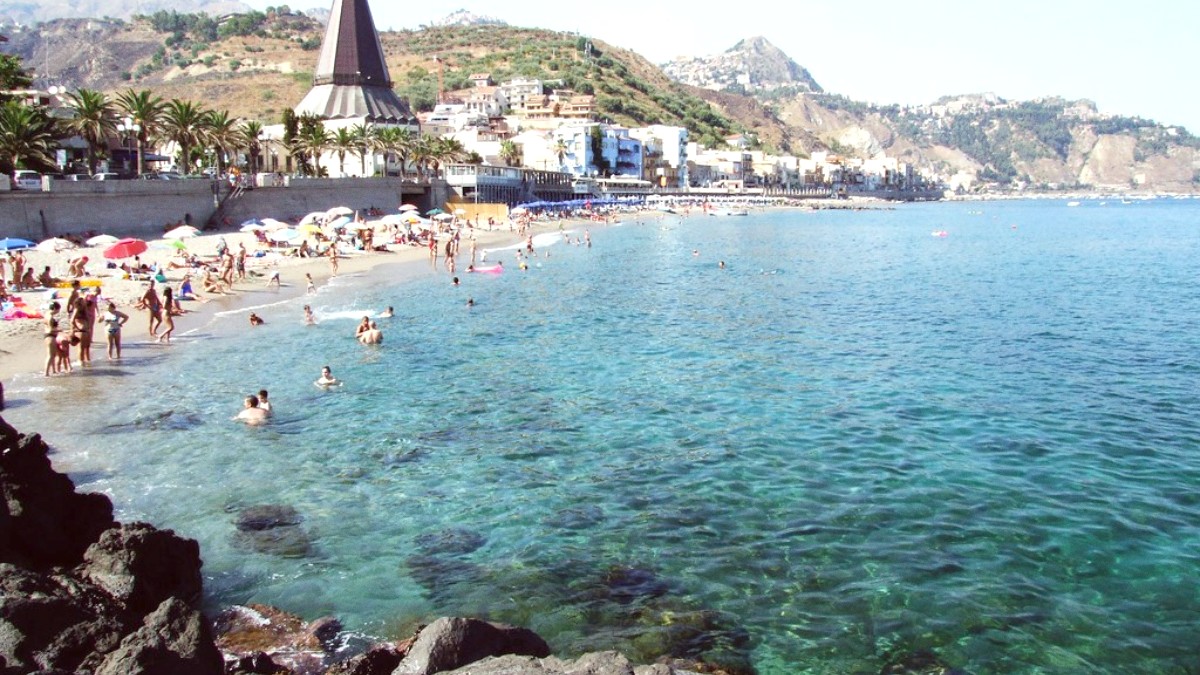
Sicily, Italy
Giardini Naxos is more than just a beach town. It is a portal to Sicily's layered past and a lively hub for its present. Here, the echoes of ancient Greek settlers blend with the warmth of modern Sicilian life. Beyond the immediate coastal charm, the town makes a great base for exploring the diverse landscapes and cultural treasures of eastern Sicily.
A trip to Giardini Naxos means choosing a place with both relaxation and adventure. Spend mornings delving into archaeological wonders, tracing the footsteps of civilizations that shaped this land. Enjoy afternoons lounging on pristine sands, cooled by refreshing sea breezes.
Evenings bring the promise of delicious local cuisine, fresh seafood, and the lively atmosphere of waterfront restaurants. Whether you seek tranquil moments by the sea, thrilling excursions up a volcano, or deep dives into history, Giardini Naxos a welcoming and memorable experience.
Giardini Naxos occupies a prime position on the eastern coast of Sicily, Italy, nestled along the shores of the Ionian Sea. This strategic coastal location, within the Metropolitan City of Messina, shapes its climate, economy, and recreational opportunities. The town's geographical coordinates, roughly 37.8306° N latitude and 15.2759° E longitude, place it firmly within the Mediterranean climate zone, ensuring warm, dry summers and mild, wet winters.
A defining feature of Giardini Naxos's geography: its relationship with Mount Etna. The town lies at the very foot of this active stratovolcano, Europe’s tallest and most active. Etna’s imposing presence is a constant backdrop, visible from almost every vantage point in Giardini Naxos. The volcano’s activity, while generally not a direct threat to the town, contributes fertile volcanic soil to the surrounding agricultural areas, which support lush citrus groves and vineyards. Occasional ashfall is a reminder of this powerful natural neighbor.
Giardini Naxos is positioned strategically between Catania to the south and Messina to the north. This proximity provides excellent connectivity, for easy reach via Catania Fontanarossa Airport and day trips to these bustling cities.
To the immediate north of Giardini Naxos lies Taormina, a prominent hilltop town renowned for its Ancient Theatre and stunning vistas. The towns are close, often considered together by travelers, connected by frequent bus services and a cable car.
The coastline presents a mix of sandy beaches, notably in the southern Recanati area, and pebbly or rocky coves closer to the archaeological park and towards Capo Taormina. Clear, calm Ionian Sea waters make the beaches excellent for swimming, snorkeling, and water sports.
The Lungomare, or waterfront promenade, stretches along much of the town’s coast. This pleasant pathway for walks offers sea views and serves as the main hub for restaurants, cafes, and lidos.
Giardini Naxos's bay is naturally protected, contributing to its calm waters and suitability as a harbor throughout history. The headland of Capo Taormina forms a natural boundary to the north, creating a picturesque bay.
The town’s layout follows the curve of the bay, with the main road (SS114) running parallel to the coast, connecting it to neighboring areas. This layout streamlines navigation, as most points of interest are easily accessible from the main thoroughfare.
Its coastal beauty, combined with the dramatic backdrop of Etna and the historical and cultural richness of nearby Taormina, makes Giardini Naxos a prime destination. The fertile lands around Etna support local agriculture, while the sea has fresh produce and opportunities for maritime activities.
This harmonious blend of land and sea, history and nature, makes Giardini Naxos a destination that offers much to explore and appreciate. Its varied landscapes and cultural depth ensure a full experience for all.
The town's unique setting against the backdrop of Europe's most active volcano and the historic Taormina creates a truly special atmosphere. Every aspect of Giardini Naxos, from its beaches to its fertile plains, tells a story of its geographical advantage.
Giardini Naxos is a deeply rooted historical significance, setting it apart as more than just a modern beach resort. It is the site of the first Greek colony in Sicily, a pivotal event in the island's ancient history. Greek colonists from Naxos in Greece founded the original settlement, named Naxos, in 734 BC. This act marked the beginning of Hellenic influence on Sicily, a legacy that shaped the island's culture, architecture, and language for centuries.
The choice of this location by the Greeks was no accident. The natural bay had a secure harbor, and the fertile land around the nearby Alcantara River provided resources for agriculture. Its strategic position, with control over coastal trade routes and access to the interior, made Naxos a flourishing commercial port and a significant military stronghold in Magna Graecia (Greater Greece).
The colonists established a city-state, building temples, public spaces, and a robust defensive wall. Remnants of these structures are still visible today in the Archaeological Park, a tangible link to this distant past.
After its initial prosperity, Naxos faced conflicts, notably with Syracuse, and was destroyed in 403 BC. However, the area retained strategic importance, and new Roman, Byzantine, and Arab settlements followed.
Each occupation left a distinct cultural and architectural imprint. Arab conquests brought new agricultural techniques and culinary traditions. Norman rule introduced grand cathedrals, blending diverse influences.
The modern name, "Giardini Naxos," beautifully encapsulates this layered history. "Giardini" refers to the citrus orchards and gardens that once characterized the area, signifying its agricultural richness and natural beauty. "Naxos" directly links it back to its origins as the first Greek colony, preserving the memory of its ancient roots. This duality reflects the town's character: a modern resort town built upon the foundations of a profoundly historical place.